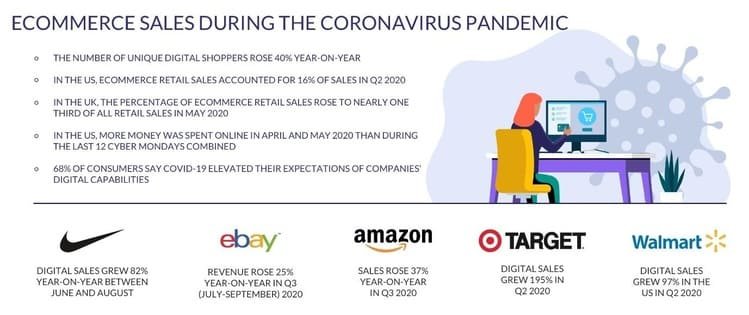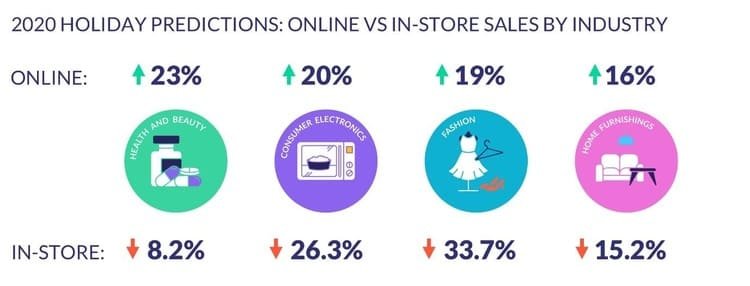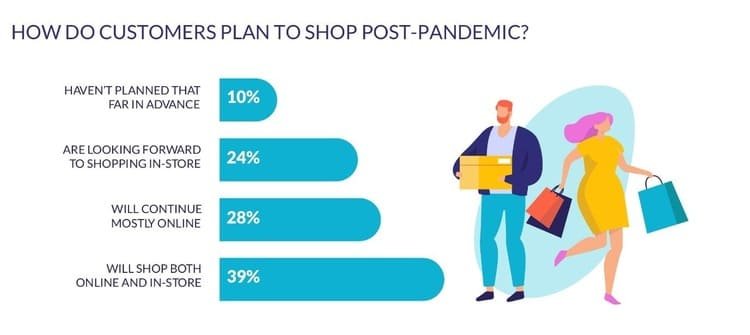The Impact of COVID and New Tech on Ecommerce
One of the least surprising results of 2020 is the fast and huge growth of global ecommerce. The living conditions due to the COVID19 pandemic restrictions combined with new technologies such as Voice Assistants (Smart home speakers) and mobile-purchasing have created the ideal setting for ecommerce to thrive in.
And thrive it has — 60% of our interactions with companies are now online, and global shoppers drove a 75% growth in digital commerce in Q2 2020 over Q2 2019 - even outperforming the high-grossing holiday shopping season of 2019.
Consumers have broken their traditional buying habits and have changed how they think of shopping, from trusting online stores more to using modern digital payment systems for the majority of their transactions. With the reliance we now all have on it, 2020 has been one of the most significant turning points for ecommerce.
COVID19 and e-Consumer Behaviour
Even without the effects of the Coronavirus, Internet sales have been increasing every year. In Great Britain alone, they’ve grown from 7.3% of all retail sales to 19.2% between 2010-19. But the acceleration from COVID is clear - in May 2020, the figure jumped to 32.8% which is a huge increase of 14% from May 2019.

As can be seen in the above graphic, some of the largest brands and retailers have – unsurprisingly - seen huge uplifts in digital sales throughout 2020.
COVID19 restrictions have created a new, emboldened confidence towards e-shopping in consumers. 62% of US consumers stated that they do more online shopping now than before the pandemic, and in one UK survey, 74% of respondents across all age groups stated that they feel comfortable buying products online because of the coronavirus outbreak.
This attitude has had varying effects on different industries too. Prior to COVID19, just 9% of consumers bought groceries online only. Now, 63% buy their groceries online with 86% saying that they’re likely to continue this way even after social distancing measures are removed. Other industries have also seen similar trends:
The decrease of in-store sales will be worrying for many retail businesses and the retail industry as a whole – in the US

A, while ecommerce sales are increasing by 18% in 2020 the total retail sales has decreased by 10.5% with a 14% drop in brick and mortar sales.
Will consumers continue to shop online more than in-stores? It’s currently uncertain, especially due to the second COVID wave and social distancing restrictions still being enforced through the holiday season. According to Selligent, consumers are mixed on how they will shop once things are back to normal:

What’s clear is that consumers are getting accustomed to spending more time online not only for shopping but also for communication, entertainment, and work. In a Salesforce survey, 61% of respondents say they expect to spend more time online after the pandemic than before it hit, and 60% say COVID-19 has changed their relationship with technology. Positively or negatively, a distinct change will be the normalised use of online stores for many people who hadn’t previously considered them.
New Tech’s Influence on Consumers
We look at some of the newest technology innovations that are shaping how consumers purchase.
- Personalization and Localization
Personalization and Localization are two important current trends in global ecommerce. Personalization is an ideal way to deliver a more personal experience to a customer. By using their browsing behaviour and purchasing history, ecommerce stores can provide customised recommendations and offers helping to increase sales. So much so, that 93% of companies have seen an increase in conversion rates when using personalized strategies.
It’s a strategy that consumers like too – 44% say they’d repeat buy from a company that used a personalized experience, and 40% stated that they bought something more expensive than planned because of personalized messaging. With so many adapting to ecommerce shopping for the first time during the pandemic, Personalization is a great way for a brand to connect with consumers and help familiarise them using a customised offering.
Localization is another way to tailor a website experience to a customer. Using their IP address, it replicates the customer’s native buying experience in terms of language, context, and currency. This is particularly important for international ecommerce stores to compete with local sellers in foreign markets. Elements such as language and currency are key to consumers placing orders – research shows that 75% of consumers prefer to buy in the native language and 33% would abandon their purchase if the pricing was only in dollars.
Clearly, it pays well to make the consumer's shopping experience personal!
- Voice Assistants and Chatbots
Google Home, Amazon Alexa/Echo, Apple HomePod… smart home speakers have exploded in popularity in the last few years. They’re now making a real impact on how consumers are buying online thanks to their convenience and speed of purchase. One in five smart speaker owners use them for voice commerce, and COVID-19 has unsurprisingly increased their use – 52% of voice assistant users have said that they’re using them ‘several times a day or nearly every day’ which is an increase of 6% pre-pandemic.
This trend is only going to increase as there are expected to be 8 billion smart home speakers in use by 2023 and that voice shopping spending will grow to over $40 billion in 2022. Due to this, 91% of 400 business decisions makers stated that they were already making significant investments into voice technology.
Another communicative ecommerce trend that’s already being implemented by many businesses are Chatbots. The helpful box that appears in the bottom right-hand corner of screens, Chatbots are a great way of providing 24/7 customer service to consumers wanting to find out order and sales information. They’re a favourite way of communicating with brands for Millennial shoppers and can save companies up to 30% in customer service spending. As millennials are one of the biggest spending age groups online, expect to see more Chatbots in future.
- Mobile Purchasing and Multichannel Marketing
A steadily increasing trend in recent years, the pandemic has really fuelled the growth of mobile-purchasing. In the first quarter of 2020, mobile ecommerce traffic grew by 25% across all industries, with mobile phones representing 56% of total order share and 71% of total traffic. These figures are only going to get larger; since the beginning of the pandemic in March 45% of consumers say they’re using their mobile phone more as a shopping channel.
Whilst it may seem that mobile purchasing has already been adapted to, this is only part of the full picture. Even though mobile has a larger total order share and more than half of all time on retail sites occurs on a mobile phone, sales through desktop computers are still worth more money on average and orders have more products. This highlights a couple of ways consumers are using mobile for ecommerce: to order cheaper, individual items, and as a research tool for larger orders that are reviewed further and eventually placed through a desktop. This multichannel approach users are taking is something brands can seize upon using a Multichannel Marketing approach.
Multichannel Marketing is a highly effective sales approach that integrates various channels such as text messages, social media platforms, and emails into a customer experience. Issues such as cart abandonment can be dealt with using this approach as there are a variety of ways a customer can be contacted and nudged to complete their order. Brands can guarantee the order by cleverly offering additional benefits such as reduced shipping or a limited time price.
Marketers using three or more marketing channels in a campaign have stated just how effective it is – they had a 287% higher purchase rate than those using just one channel as well as a 90% higher consumer retention rate. We’ve seen how consumer’s habits and behaviour has changed, so it’s wise to tailor future marketing approaches to this.
Wrapping Up
Ecommerce won’t be the same after 2020. It’s become an integrated, necessary part of society even reaching consumers who had never used it before, and the innovations we’ve looked at will only help to assimilate ecommerce into their lives further. Companies and brands now face a crucial stage of how they will adapt to an unpredictable and ever-evolving world, and how they’ll use New Tech to stay ahead of their competitors. The future of ecommerce has never been more exciting!
About the Author
Hannah Whitfield writes for Website Builder Expert, a leading resource for getting people online. A good website is an essential for any modern business, and Hannah wants to help readers get the most out of theirs.